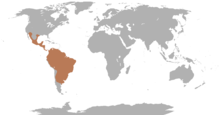
Hi Everybody!!
If you are new to noticing, documenting and photographing the Nature around you, I just want to tell you one thing: you will not run out of things to photograph! There will be new surprises everyday, so keep your camera with you. Today I got a dog and a pig at the end of my street. These 2 are obviously friends and the dog was protecting the pig. Now some may find it strange to run into a dog and a pig just by chance walking around your road. I learned along time ago not to question anything that appears before my eyes! This is not just any pig, it is a wild pig with a pet dog. I have shared below info on Javalina from Wikipedia so you can know about these wild pigs. He lives in the woods probably behind the dogs house. Remember, I had hundreds of buzzards staying here for the winter, so a dog and a pig is almost normal! Be ready for surprises in your life. Enjoy!






https://plus.google.com/u/0/photos/117645114459863049265/albums/5990286127478906433




http://en.wikipedia.org/wiki/Peccary
Peccary
From Wikipedia, the free encyclopedia
A peccary (or javelina and skunk pig; Portuguese javali and Spanish jabalí, sajino orpecarí) is a medium-sized mammal of the family Tayassuidae, or New World pigs.[1]Peccaries are members of the artiodactyl suborder Suina, as are the pig family (Suidae) and possibly the hippopotamus family (Hippopotamidae).[2] They are found in the southwestern area of North America and throughout Central and South America. Peccaries usually measure between 90 and 130 centimetres (3.0 and 4.3 ft) in length, and a full-grown adult usually weighs between about 20 to 40 kg (44 to 88 lb). The word “peccary” is derived from the Carib word pakira or paquira.[3]
Peccaries, which are native to the Americas, are often confused[4] with the pig family that originated in Afro-Eurasia, especially since some domestic pigs brought by European settlers have escaped over the years and now run wild as "razorback" hogs in many parts of the United States.[5]
In many countries, they are raised on farms and are a source of food for local communities, especially in the developing world.[6] Their skin, being both rigid and strong, as well as soft and supple, is recognized as being ideal for the production ofleather gloves.[7]
| Peccaries Temporal range: Late Eocene–Recent | |
|---|---|
 | |
| Collared peccary, Pecari tajacu | |
| Scientific classification | |
| Kingdom: | Animalia |
| Phylum: | Chordata |
| Class: | Mammalia |
| Order: | Artiodactyla |
| Suborder: | Suina |
| Family: | Tayassuidae Palmer, 1897 |
| Genera | |
 | |
| Range of the peccaries | |
Characteristics[edit]
A peccary is a medium-sized animal, with a strong resemblance to pigs. Like pigs, it has a snout ending in a cartilagenous disc, and eyes that are small relative to its head. Also like pigs, it uses only the middle two digits for walking, although, unlike pigs, the other toes may be altogether absent. Its stomachis nonruminating, although it has three chambers, and is more complex than those of pigs.[8]
Peccaries are omnivores, and will eat small animals, although their preferred foods consist of roots, grasses, seeds, fruit,[8] and cacti—particularly prickly pear.[9] Pigs and peccaries can be differentiated by the shape of the canine tooth, or tusk. In European pigs, the tusk is long and curves around on itself, whereas in peccaries, the tusk is short and straight. The jaws and tusks of peccaries are adapted for crushing hard seeds and slicing into plant roots,[8] and they also use their tusks for defending against predators. The dental formula for peccaries is: 2.1.3.33.1.3.3
By rubbing the tusks together, they can make a chattering noise that warns potentialpredators not to get too close. In recent years in northwestern Bolivia near Madidi National Park, large groups of peccaries have been reported to have seriously injured or killed people.[10]
Peccaries are social animals, and often form herds. Over 100 individuals have been recorded for a single herd of white-lipped peccaries, but collared and Chacoan peccaries usually form smaller groups. Such social behavior seems to have been the situation in extinct peccaries, as well. The recently discovered giant peccary (Pecari maximus) of Brazil appears to be less social, primarily living in pairs.[11]
Peccaries have scent glands below each eye and another on their backs, though these are believed to be rudimentary in P. maximus. They use the scent to mark herd territories, which range from 75 to 700 acres (2.8 km2). They also mark other herd members with these scent glands by rubbing one against another. The pungent odor allows peccaries to recognize other members of their herd, despite their myopic vision. The odor is strong enough to be picked up by humans, which earns the peccary the nickname of skunk pig.

...this is brendasue signing off from Rainbow Creek. See You next time!


O+O


No comments:
Post a Comment
Hi Everybody! Please say hello and follow so I know you are here! Due to the inconsideration of people trying to put commercials on my blog comment area, I have restricted use of anonymous posts. Sorry that some hurt all.
My public email is katescabin@gmail.com No spammers or trolls